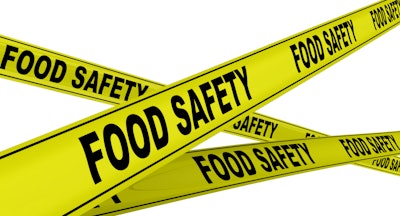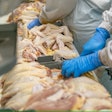
Food safety will always be a top concern for the poultry industry, and to help producers prevent illness and recalls, Mike Evans of Eagle Quality Assured presented the North American Meat Institute’s (NAMI) hygienic design guidelines at the International Production and Processing Expo (IPPE) 2024.
According to Evans, a hygienic design minimizes the risk of contamination and is easy to clean.
The 10 principles of hygienic design
1. Made of compatible materials
Facility materials must be degradation resistant, non-toxic, non-absorbent and not coated – like 300 series stainless steel, plastic (UHMW, HDPE, etc.) and polyurethane.
2. Accessible for inspection, maintenance, and cleaning and sanitation
Equipment should be easily disassembled for cleaning and have 12 inches of clearance from the ground.
Air hoses and vacuum lines should be transparent.
3. No material collection
Surfaces should not collect product, liquid or other material, especially in the product zone. Self-drainage and angled surfaces help prevent collection.
4. Hermetically sealed hollow areas
If hollow areas in machinery are unavoidable, they must be hermetically sealed.
5. No niches
Non-food contact surfaces should have 125 u-inch roughness average (RA) while food contact surfaces must have 32 u-inch RA.
Welds should be smooth, and internal corners should have a minimum 1/8 inch radius.
6. Operational performance
Control panels, motors and bearings should not be in the product zone, and equipment in the product zone should be designed to prevent product build-up.
And if any compressed air is used on a product, it should be dry and filtered.
7. Maintenance enclosures
Maintenance enclosures should not be in the product zone, and enclosure cables should be organized to allow enough space for the enclosure to be thoroughly cleaned.
8. Compatible with other plant systems
Pneumatics, ducts, fans, etc., should not blow into the product zone.
9. Cleanable to a microbiological level
Equipment should be accessible for mechanical cleaning, and according to Evans “must be clean based on sight, touch and smell.”
10. Validated cleaning and sanitizing protocols
The equipment’s design – its construction and materials – should take cleaning into account and should also come with sanitation procedures when purchased.
The consequences of poor food safety
According to Evans, 1 in 6 Americans get sick from a foodborne illness and 3,000 people die every year.
And in 2021, 15 million pounds of product were recalled, with each recall costing approximately $10 million.
For more information on hygienic design principles, visit https://www.meatinstitute.org/Food_Safety
















